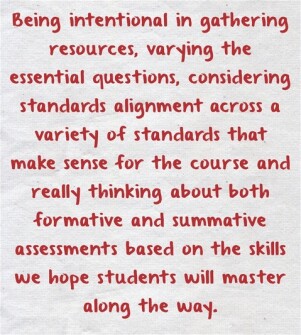
I’m such a nerd, and I love it. I’ve had the opportunity recently to participate in and/or oversee a number of curriculum writing projects and honestly, as a person who really enjoys the ins and outs of what makes a classroom sing, curriculum writing is essentially the score that promotes the song.
Of course, from concept to concrete map and then implementation, flexibility is key to ensuring the basic skills and content are accessible to all students. And more importantly, that the students are involved in shaping the implementation and eventual revision of the map as we go.
When creating an elective from scratch for example, after a proposal to run a new class has been accepted, one has to consider what the objectives were and how to ensure those objectives are met, but also provide avenues for voice and choice for all participants, students, and teacher.
A curriculum map is fluid; we write down our intentions and then are mindful of the shifts based on the realities of the classroom and its genetic makeup of students. Being intentional in gathering resources, varying the essential questions, considering standards alignment across a variety of standards that make sense for the course and really thinking about both formative and summative assessments based on the skills we hope students will master along the way.
While on one particular writing project, I’ve had the chance to reconnect with my journalism background and it makes me long for the days of my newspaper class where students were in charge of everything. It took a few years to get to that place, but after the structures were in place, the safety net of my map was adapted broadly based on the students in the space and their interest. The pacing was determined on their readiness and the crop of students who came before them.
I was fortunate enough to loop with students, a junior class, and a senior class. Basic skills were taught before they got to Newspaper as I all students took a “Foundations in Journalism” class in the ninth grade. (I often taught that class too and when I didn’t, my original map was shared and adapted for new teachers.) Since my school was journalism-themed, there was an articulation of journalism skills 6-12 that helped ensure success. Being a part of those curriculum writing projects was empowering. Knowing that I had the ability to participate and also adjust as needed made the classes become what they did.
Years into that program, students ran the show and that is what I hope for now as well. Learning happens best when kids are in the driver’s seat and it is the teacher’s and leader’s responsibility to make sure they are driving ready and then let go to navigate. Kids know more than we give them credit for and teachers are more capable of making change than they realize themselves.
So here are some things you can do to ensure that a class has a strong skeletal structure, but also incorporates elements of flexibility to easily adjust curriculum as you go:
- Remember that a curriculum map is a living document and should be adjusted based on what is actually taught. It’s all good to make plans, but if we aren’t responsive to the needs of our students, we aren’t doing our jobs right.
- Write your curriculum map in a format like Google Docs, so that it can easily be adjusted regularly and earlier versions of the document are saved in the revision history.
- Never make changes without tracking expectations and reflecting on why it did or didn’t work. Remember, that although it doesn’t work this year, doesn’t mean with a different group of kids it can’t work.
- Build areas into assessments that call for student voice and choice as well as student-curated content to use in the future.
- Capitalize on the students in your classes, asking for feedback regularly and using that feedback to adjust as needed.
- Make sure content addresses a wide variety of interest and encompasses many perspectives.
- Build resources into the document that can be used and added to regularly.
- Have a differentiation plan so that all kids can be successful.
- Write in collaborative opportunities while teaching collaboration skills and offering a lot of opportunities to provide feedback and reflection for students.
- Teach students to adapt and create assessments and success criteria so that later months student-generated work will be what guides curriculum
- Remember that ultimately, we want to develop a completely student-centered environment which means slowly taking the training wheels off throughout the year; make sure that gradual release is developed in the map explicitly.
Learning is deeply personal and engaging when done right and every school can be developing lifelong learners by setting up expectations that involve student and teacher participation. We must always remember that it is the student learning that matters. Teacher passion and interest is important, but not at the expense of the students’ needs.
How can we ensure student-voice and choice permeates the learning in our spaces? Please share